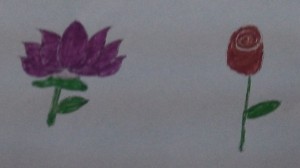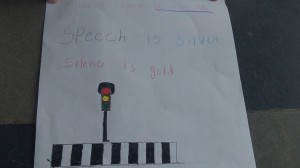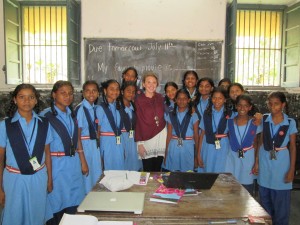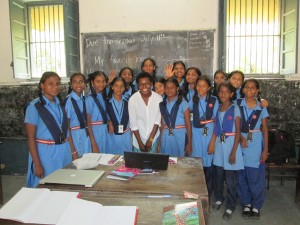Ask any of us fellows to describe Hyderabad, and inevitably one of the adjectives will be “chaotic.” Hyderabad is notorious even among Indians for its complete lack of traffic etiquette, in which everyone from the pedestrians to busses to cows thinks they have complete jurisdiction over the road. Walking, biking, and driving as though everyone should get out of your way is not a choice, but the only means to survive in the gnarly traffic congestion. Aside from the traffic, the city’s diverse population offers different languages, religions, and cuisine on every corner. In our schools, cramped classrooms, and constant festival interruptions can also foster a sense of chaos while teaching. Combined, it is a lot for the brain to handle, but rest assured it is never boring. Which is why we have all come to love it.
But that all changed for one day this week. On Tuesday, Rachel and I decided to run an errand. We had class off due to a government-mandated holiday, but different holidays and festivals pop up quite often so we didn’t think much of it. Then we actually walked outside.
Our normally bustling street was entirely deserted. Not a single auto, car, motorbike, or even a stray dog in sight. There were one or two people walking silently, alone, down the block and a man at a nearby samosa stand quietly frying his snacks, but that was it—Hyderabad had shut down. As we walked to the main road, the silence and lack of traffic persisted, and became almost creepy. We made it to the main four-lane road that usually teems with traffic, but on Tuesday we could have walked down the middle of the avenue safely for miles. We quickly realized the errand wasn’t going to happen.
The reason for this shut down was a massive survey of Telangana. It was sort of like a census, but with more economic implications—government workers asked for things like bank account numbers and property owned. It was both to take measure of how many people qualified for welfare programs, but also to fully understand who makes up the state of Telangana and what they need. For the newest state in India, taking note of these statistics will be key to making the state successful in the future.
But in the meantime, students and teachers are especially feeling the growing pains. One of my principals said he feels the current group of students may become a “lost generation” as their schooling may end up riddled with assessments and surveys to better understand how to improve Telangana’s literacy rates and school systems. As Andhra Pradesh and Telangana grapple with dividing electricity between two separate states, frequent power cuts darken classrooms and cut into any digital learning efforts. Teachers are also being tasked with many of these extra efforts. While Rachel and I were able to at least go home and continue lesson planning, teachers at both my schools were appointed to conduct the survey because they are government workers. This meant taking precious days off to knock on citizens’ doors and ensure they had given their information to the government.
Though these steps are necessary for the greater good of the state and students and India, it made me think about how we ensure students learn, even while we search for solutions to education’s issues.
Here in India, being as consistent as possible has been key. Even though the last month has been riddled with holidays, interruptions, and festivals, whenever we show up to class students seem increasingly confident that we aren’t going to let their sometimes helter-skelter schedules get in the way of making films. Talking about it is good too—both with teachers and students. Teachers appreciate a well-deserved sympathetic ear and students are eager to talk about their festival celebrations. Other than that, the basics of being a good teacher apply: be as enthusiastic as possible, encourage thoughts outside of class, convince the students to be as hungry for TMS class as possible—a task not too difficult given they get to take photos and videos most days. Even after a two-week break from Railway Girl’s School due to holidays and an Independence Day celebration, I was so impressed that students jumped right back into their project without missing a beat.
I also think this has implications in the United States, where education reform is a divisive topic. Right now public education is being tested, prodded, and examined from every possible angle by activists, politicians, and business owners. Think about the methods we are trying out as solutions: Common Core, charter schools, Teach for America. Will they work? Many are gambling students’ only education in hopes that these programs make a difference. Who’s to say we may look back one day at kids who are currently in class and call them the “lost generation” of students in the US?
It used to be that thinking about the attempted solutions in the US gave me more worry than hope. I still remain skeptical about most solutions, especially when they come from business-backed initiatives or claim to solve the problems of underserved districts by closing public schools. But being an educator has actually given me faith in one area of education: teachers. If teachers can create a sense of excitement passion and about learning that extends beyond the classroom, students will thrive even if a charter school ends up shutting down or assessments don’t provide conclusive results.
I’m still getting to that point in my own teaching, but I do feel that TMS has curriculum and projects that bring out intrinsic motivation that can carry with students for the rest of their lives. Critical thinking, creativity, and the ability to visually convey ideas far outlast any power cut or missed class. The key anywhere in the world, to me it seems, is supporting teachers that bring that out in their students, regardless of the policy solution of the day.




